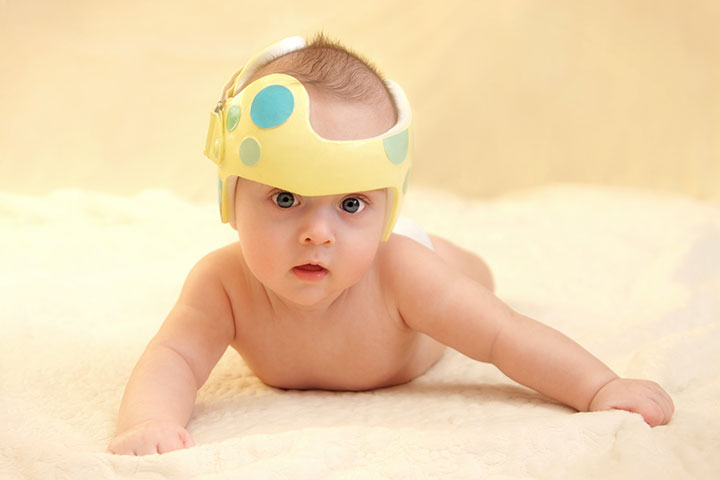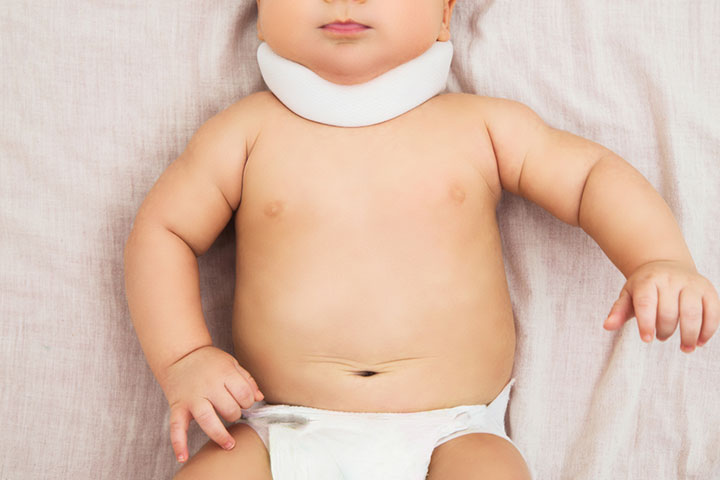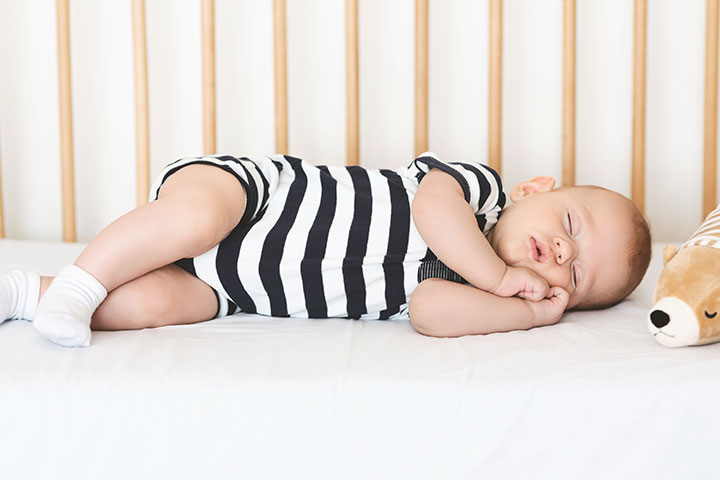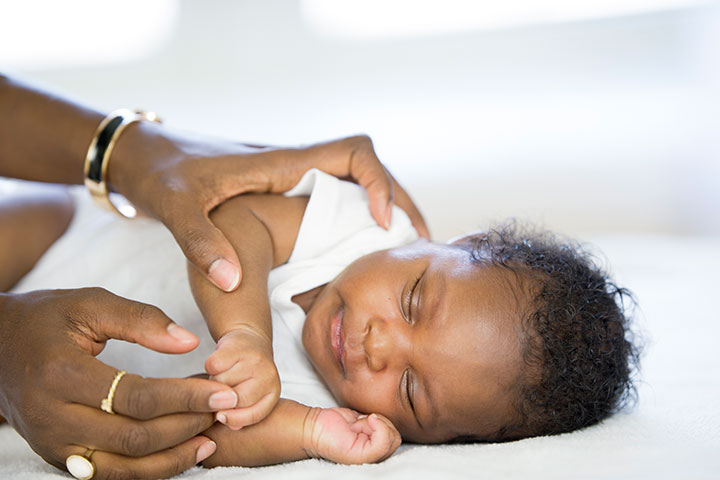Experts recommend that pregnant mothers sleep on their left side to ensure more nutrients flow to the baby. However, parents often wonder about the benefits or risks of babies sleeping on the side.
Babies have different sleep patterns, and many may prefer to sleep on their sides. Although this trait is harmless in adults, it may cause adverse effects in babies. If babies regularly sleep on their side, they may develop health conditions such as flathead or a tilt in the neck and increase their risk of choking.
This post explains why babies should not sleep on their side, how sleeping on one side can affect infant health and wellness, when babies can sleep this way, and what to do when they roll to one side. It also provides tips to prevent babies from rolling to one side.
Is It Safe To Make The Baby Sleep On One Side?
If you’re curious about whether newborns can sleep on their side, it’s important to note that it’s not recommended. This sleeping position could potentially lead to health complications as mentioned below:
1. Harlequin color change:
The medical term for harlequin color change is unilateral erythema, and it affects nearly 10% of newborn babies (1). It is usually seen in the first week of birth. In this condition, the sleeping side of the infant’s body turns pink or red with a clear demarcation running through the central axis of the baby’s body. This means the baby’s body will be half red and half normal-colored. The color will change spontaneously when the infant sleeps on the side for hours.
But the condition is completely benign and does not cause any lasting health issues. Switching the position of the baby makes the red color fade away within minutes.
Medical experts do not know the precise reason for this phenomenon, but they suspect it occurs due to the immature blood vessels in the skin. It may also be associated with polycythemia (a dark red baby due to the increased red blood cells in the body). The color indicates a possible accumulation of red blood cells, due to gravity, among the cutaneous blood vessels (blood vessels close to the skin). This could happen due to the immature blood vessels in babies.
Treatment: Harlequin color change is a harmless condition and disappears on its own.
2. Flatheads:
The bones of a baby’s skull remain soft and malleable to allow the skull expand at the same rate as the brain. The soft bones naturally pose a risk of developing flatheads. Flathead happens when the baby’s head is placed in a single position repeatedly to the extent that pressure builds up at a single spot on the skull. The bones of the skull at that point sink and go concave or flatten. It is basically a skeletal anomaly but can lead to stuntediXImpeded growth and development. brain growth due to less cranial spaceiXThe area formed by the bones of the skull and contains the brain. for the brain to expand. This may hamper the baby’s cognitive abilities later in life. The medical term for a flathead is plagiocephaly. A report published by the American Academy of Pediatrics (AAP) states that in six-month-old babies, the incidence rate of deformational plagiocephaly is estimated to be about 20-50%.
Flatheads also occur if the baby sleeps straight but puts his head to the side, and due to prolonged sleeping on one side (2). A neck condition called torticollis could also lead to flatheads.
A more rare form of plagiocephaly is due to abnormal bone formation in the skull, which has to be surgically corrected.
Treatment: When diagnosed on time, flatheads can be corrected with the use of head braces called baby helmets since the baby’s skull bones are still soft enough to reposition themselves. The head braces are prescribed by the doctor and made by certified medical manufacturers or hospitals.
If the baby’s condition is not severe, then the doctor will simply recommend repositioning your baby’s sleeping side to rectify the flathead (3).
3. Torticollis:
Torticollis is an abnormal tilting of the neck in one direction due to the severe shortening of the sternocleidomastoid muscle that connects the lateral side of the head to the clavicle. Torticollis can occur due to several reasons, one of them being the poor positioning of the baby while sleeping (4).
Since babies’ muscles are tender and growing, the sternocleidomastoid muscle may shorten due to repeated sleeping on the side or turning the head to the side while sleeping on the back. This condition will not just affect the growth of the muscle but also cause abnormal bone growth.
Babies with torticollis turn their head side-to-side while sleeping.
Treatment: Physical therapy will help release the stiffness in the muscles (3). The doctor may recommend wearing a recovery harness that is wrapped around the baby’s body with a soft pad near the neck. This pad pushes the head in the opposite direction, gradually bringing back the neck to its normal position. The doctor will also give you some safe sleeping techniques for the baby’s condition to improve.
4. Risk of choking:
Sleeping on the side creates torsioniXTwisting of a part due to an applied force in the windpipe (trachea) that can make breathing difficult for the baby. Also, it can result in the accumulation of regurgitated foodiXSwallowed food brought back from a person’s stomach to their mouth around the tracheal opening, posing a choking hazard. This also happens during tummy sleeping – a position to which your baby may topple during side-sleeping. These positions increase the risk of sudden infant death syndrome (SIDS) (5). Moreover, a safe and exclusive sleep environment is crucial for babies; co-sleeping or bed-sharing may increase the risk of SIDS.
Treatment: Do not allow the infant to sleep on his side to prevent choking and SIDS. Additionally, providing the baby with a pacifier during sleep may lower the likelihood of SIDS.
These repercussions, some long-term and some temporary call for the need to prevent your baby from sleeping sideways.
How To Prevent Your Baby From Side-Sleeping?
You can take some easy precautions to prevent your baby from sleeping on his side:
1. Place your baby on the back during sleep time:
The simplest precaution is to place your baby on his back when putting him to sleep in his crib or cradle. Research has proven that the back sleeping position is the best way of preventing fatal medical conditions such as SIDS (6). This position also reduces upper respiratory issues and infections.
2. Do not place unnecessary support structures on the bed:
Do not place support structures on the crib or the bed of the baby. These structures could be anything from home pillows to specially-made crib bumpers that have no proven record to provide any benefit or safety to the sleeping baby. Certain support structures like pillows may even cause the baby to roll over to the side in case he moves during his sleep (6).
3. Never use sleep positioners or wedges:
Sleep positioners are not safe for babies. In fact, some are designed to ensure that the baby sleeps on the side while some encourage the baby to sleep on the back. Avoid both such positioners. Sleep positioners have been proven to pose a suffocation hazard (7).
4. Swaddling may increase the risk of roll over:
If you swaddle your baby you automatically increase the risk of him rolling over to the side. This is because swaddling creates a smooth cylindrical surface around the baby that makes it easy for him to roll over. In fact, swaddling could increase the risk of SIDS (8).
5. Keep altering the baby’s sleep positions:
If your baby sleeps on his back, then switch the position of his head every alternate night. For example, if he sleeps on his back with his head rested a bit towards the left side then the next night gently shift his head to the right side. This will help prevent the development of flatheads. Also, put your baby to sleep in a separate crib or cradle in the same room where you sleep. Do not put unnecessary bedding or padding in the crib that will make the baby slip into side-sleeping position. Ensuring crib safety is crucial in reducing the risk of Sudden Infant Death Syndrome (SIDS). One effective measure to prevent SIDS is to use a sleeping bag that fits your baby correctly, as it helps keep their head and face uncovered.
In the initial months, the babies do not move much. But once their mobility improves, it could be difficult for you to make him sleep on the back. So, for how long should you make an effort to make him sleep straight?
When Can Babies Sleep On Their Side?
Babies should be made to sleep on his back till they complete 12 months, after which he can sleep on his side (9). By this age, your baby’s esophagusiXA muscular tube that passes food and liquids from the mouth to the stomach., trachea and overall breathing mechanism are fairly developed. Thus, it is now safe for him to sleep on his side.
What If The Baby Rolls To Side In Sleep?
At around six months of age, your baby could roll over to his tummy or the side from the back position. Rolling over is a natural part of your baby’s development. If your newborn rolls to the side while sleeping or over to the tummy on his own, then you can let him sleep in that position (9).
Generally, a baby will get on to the side or stomach sleeping position only when his muscles are strong enough to let him do so. If he can roll over on his own then it is an indicator that the baby has stronger internal organs and is at a lower risk of choking himself during sleep.
However, if your newborn rolls to the side to sleep, then you must put him in the back position again.
Babies sleeping on their sides have an increased risk of developing a flathead or suffering from torticollis which results in abnormal tilting of the head. However, if your baby naturally rolls into a side sleeping position, do not change their stance, as it is a part of their development and will not lead to any complications. Making your baby sleep in a sideways position also increases the risk of choking. Remember to make your baby sleep on their backs and keep altering the positions of their heads on alternate days to prevent flatheads.
Ensure your baby’s safety and well-being with this video on Infant Safe Sleep Practices. Learn valuable insights on creating a secure sleep environment for your little one.
Key Pointers
- Medical experts advise against side-sleeping in babies due to potential risks such as flathead, neck tilt, and choking.
- The safest sleeping position for infants is on their back, as it reduces the risk of fatal medical conditions and respiratory illnesses.
- Avoid using support structures, sleep positioners, and wedges, as they can be dangerous or increase the likelihood of side sleeping.
- Infants should only sleep on their side after 12 months when their breathing and digestive systems are better developed.















